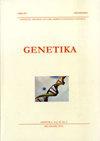利用起始密码子靶向多态性(SCoT)和CAAT-Box衍生多态性(CBDP)标记研究一些Aegilops物种的分子变异
4区 农林科学
Q3 Agricultural and Biological Sciences
引用次数: 0
摘要
在小麦的野生近缘种中,Aegilops是发现小麦抗环境胁迫乃至籽粒品质等新性状的理想遗传资源。因此,了解该种质资源的群体结构和遗传多样性对其保护和进一步利用具有重要意义。在本研究中,有80个加入的Aegilops,包括Ae。tauschii, Ae。白茅和Ae。利用SCoT和CBDP标记研究了三孔蝇的遗传多样性。8条SCOT引物和12条CBDP引物共扩增出84个和94个片段,平均每条引物扩增10.50个和7.83个片段。SCoT和CBDP引物的分辨能力(Rp)分别为6.04 ~ 11.65和13.08 ~ 28.02,多态性信息含量(PIC)分别为0.40 ~ 0.49和0.35 ~ 0.48。分子变异分析(AMOVA)结果表明,种间遗传变异比例最高。在所有测试材料中,SCoT引物的所有信息参数(除分辨率外)都比CBDP引物高。然而,CBDP引物比SCoT引物显示出更高的遗传参数值。因此,有效等位基因数(Ne)、Nei?s基因多样性(H)和Shannon?s信息指数(I)。白茅和Ae。分别使用SCoT和CBDP标记。基于这些分子系统的聚类分析将所有的材料分成三个主要的聚类。利用CBDP引物观察到的类群模式表明,某些种间的系统发育关系较为明确,因此PCoA?S的结果证实了分组模式。综上所述,SCoT和CBDP标记在描述被测种质间多态性方面效率较高,而CBDP标记对被测种质提供了清晰的分组模式。因此,推荐使用CBDP标记来确定其他植物物种的群体结构和估计遗传多样性。本文章由计算机程序翻译,如有差异,请以英文原文为准。
Investigation of molecular variability in some Aegilops species using Start Codon Targeted Polymorphism (SCoT) and CAAT-Box Derived Polymorphism (CBDP) markers
Among wild relatives of wheat, Aegilops species are ideal genetic resources for the discovery of new characteristics such as resistance to environmental stresses and even grain quality for wheat improvement. Hence, knowledge of the population structure and genetic diversity of this germplasm is very important for their conservation and further utilization. In the present study, 80 accessions of the Aegilops including Ae. tauschii, Ae. cylindrica and Ae. triuncialis were investigated for genetic diversity using SCoT and CBDP markers. Eight SCOT and twelve CBDP primers amplified a total of 84 and 94 fragments with a mean of 10.50 and 7.83 fragments per primer, respectively. Resolving power (Rp) for SCoT and CBDP primers varied between 6.04 and 11.65, and 13.08 and 28.02, with the polymorphic information content (PIC) from 0.40 to 0.49 and 0.35 to 0.48, respectively. The results of analysis of molecular variance (AMOVA) indicated that the highest proportion of genetic variance referred to between species. SCoT primers indicated high values for all informativeness parameter (except resolving power) than CBDP primers across all tested accessions. However, CBDP primers indicated higher values of the genetic parameters than using SCoT primers. As a result, the maximum values for genetic parameters such as number of effective alleles (Ne), Nei?s gene diversity (H) and Shannon?s information index (I) were detected in Ae. cylindrica and Ae. triuncialis using SCoT and CBDP markers, respectively. Cluster analysis based on those molecular system grouped all accessions into three main clusters. The grouping pattern observed by CBDP primers indicated more clear phylogenetic relationship among some Aegilops species, so that PCoA?s results confirmed the grouping pattern. In conclusion, it was observed that SCoT and CBDP displayed good efficiency in depicting polymorphism among the tested accessions, however, CBDP markers provided a clear grouping pattern of evaluated accessions. Hence, the use of CBDP markers in determining population structure and estimating genetic diversity in other plant species is recommended.
求助全文
通过发布文献求助,成功后即可免费获取论文全文。
去求助
来源期刊

Genetika-Belgrade
AGRONOMY-GENETICS & HEREDITY
CiteScore
1.80
自引率
0.00%
发文量
1
审稿时长
6-12 weeks
期刊介绍:
The GENETIKA is dedicated to genetic studies of all organisms including genetics of microorganisms, plant genetics, animal genetics, human genetics, molecular genetics, genomics, functional genomics, plant and animal breeding, population and evolutionary genetics, mutagenesis and genotoxicology and biotechnology.
 求助内容:
求助内容: 应助结果提醒方式:
应助结果提醒方式:


